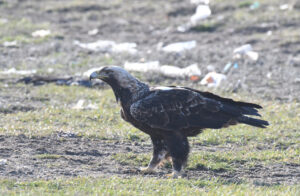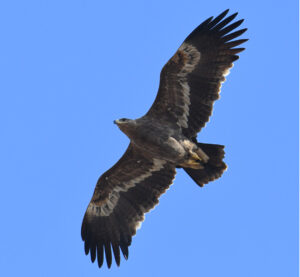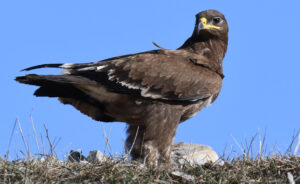Third International Scientific and Practical Conference “Eagles of the Palearctic: Study and Conservation”
Raptors Conservation. Suppl. 2. Proceedings of Conferences
Migration of the Eastern Imperial Eagle and Steppe Eagle in Turkmenistan
Rustamov E.A., Khodzhamuradov H.I., Veyisov A.S. (Menzbeer Ornithological Society, Moscow, Russia)
Contact:
Eldar Rustamov elldaru@mail.ru
Khodzhamurad Khodzhamuradov hojamurad@mail.ru
Atamyrat Veyisov atamyratveyis@gmail.com
Recommended citation: Rustamov E.A., Khodzhamuradov Kh.I., Veyisov A.S. Migration of the Eastern Imperial Eagle and Steppe Eagle in Turkmenistan. – Raptors Conservation. 2023. S2: 160–162. DOI: 10.19074/1814-8654-2023-2-160-162 URL: http://rrrcn.ru/en/archives/34936
A dedicated analysis of spring and fall migration of the Eastern Imperial Eagle (Aquila heliaca) and Steppe Eagle (Aquila nipalensis) in Turkmenistan has never been conducted before. Both species have been considered migratory, although in the last decade some individuals began to overwinter. Wide portions of their flyways pass over Turkmenistan. Both species are more often found and concentrated in the southern half of the country and areas containing an abundance of Great Gerbil (Rhombomys opimus) and Libyan Jird (Meriones erythrourus), especially in population outbreak years.
The migrating Imperial Eagle may be encountered almost everywhere, preferring areas in various open habitats in the flat parts of the country. It is difficult to estimate the total number of migrating Imperial Eagles, as well as Steppe Eagles, because it is rarely possible to record them over large areas during migration.
We have put together the few known facts: a migrating flock of 26 individuals was recorded on April 28, 1939, near the Karabogazgol Strait (Isakov, Vorobyev, 1940); after detailed observations in 1949– 1958 the Imperial Eagle was recorded twice in Badkhyz (Sukhinin, 1971), and only once in 1984–1997 (Bukreev, 1997); 37 Imperial Eagles have been observed in a flyway on October 20, 1976, in the delta of the Murghab River (in the Karakum lowlands), 36 km north of the village of Chashgyn.
In the South-Eastern shore of the Caspian Sea there were 2 sightings over the period of 1977–1991: in October 1977 (3 individuals near Maloye Delili Lake) and March 1979 (2 individuals near Cheloyuk settlement) (A.A. Karavaev, unpublished data);
In Central Kopetdagh in 1990–2010 this eagle was recorded only 7 times, with 1–2 birds observed each time, for a total of 27 birds (Efimenko, 2010), including once a flock of 9 individuals (Efimenko N.N., unpublished data);
In the Western Kopetdagh in 2009–2018 it was also recorded 7 times, usually 1–2 individuals, with one observation of 6 individuals at one time (March 6, 2015) (Khodjamuradov, Rustamov, 2010; 2019).
Although Steppe Eagles can be found throughout Turkmenistan, they migrate mostly over the western and southeastern parts of the country. The first flyway is predominantly over the Western Kopetdag and then through Southern Ustyurt (territories surrounding Karabogasgol bay and Sarakamysh lake), while the other goes through the broader Badkhyz corridor further along the edge of the Southeastern Karakum and Karabil to the southern half of the Sundukly Desert (Tallimerjen massif).
Individual migrant streams can be traced along the foothills of the Bolshoi Balkhan and Maliy Balkhan, Kopetdag and/or across the Karakums. At the same time, birds can be seen everywhere in small groups and even singly (as if in isolation, but parallel to the main stream), crossing the flat portion of Turkmenistan in a broad front. Compared to the Imperial eagle, there are considerably more recorded sightings of Steppe Eagles (detailed analysis is given in the report).



